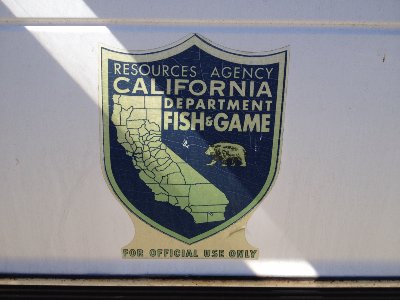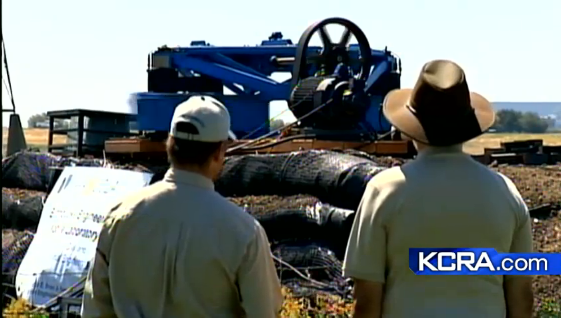|
Review Panel Assesses Controversial Hatchery Practices
|
|
|
Throughout the history of California, dams have been built for a variety of reasons including hydropower, flood protection, and irrigation, but the construction of all these dams has been a blow to the state's salmon. It is estimated that dams have eliminated 48% of the salmon habitat (Yoshiyama et al. 1996), and in many cases fish hatcheries were constructed to mitigate for this loss. The history of hatcheries in California goes back well over a century. The first publicly owned fish hatcheries were established in 1870, only 20 years after California became a state. Construction of the Coleman National Fish Hatchery began in 1942 on Battle Creek to mitigate the loss of anadromous fish habitat on the Sacramento River. Over the next 50 years the state opened four more hatcheries along Central Valley tributaries: the Feather, American, Mokelumne and Merced Rivers. Today California hatcheries produce more than 32 million fall-run Chinook salmon annually.
For many years there has been rising concern for how hatchery salmon affect the natural spawning populations. Rather than focusing on preserving the naturally spawning individuals of a vulnerable species, hatcheries are often focused on producing a certain number of salmon to meet mitigation requirements. In 2000, the U.S. Congress initiated a review process that assessed the hatchery programs in the Puget Sound and coastal Washington, and then in 2005 the Columbia River. The reviews proved to be successful in consolidating knowledge of hatchery operations and objectives, and recommending more refined hatchery practices. In 2010 Congress approved funds to form the California Hatchery Scientific Review Group (CA HSRG) to begin a similar review process for California. The goal of the CA HSRG is to evaluate the hatchery programs to ensure that they are being effectively managed and operated in a way that ensures that they meet one or both of their goals; (1) helping recover and conserve naturally spawning salmon and steelhead populations, and (2) supporting sustainable fisheries with little or no deleterious consequence to natural populations.
After nearly two years of evaluating hatcheries throughout California, the CA HSRG has submitted a report on their observations and suggested modifications to hatchery operations (HSRG, 2012). An example of one such recommended change is to move to 100% marking and tagging programs. In 2007, the Constant Fractional Marking (CFM) program was initiated and hatcheries began marking and tagging 25% of fall-run Chinook salmon production. With the CFM program, estimates of hatchery origin fish are calculated at the end of the year, but 100% marking would allow for real-time identification of all hatchery origin fish. Additionally, it has been well documented that trucking the hatchery fish to the San Francisco Bay has led to increased straying. If the hatcheries were to cease the trucking operations, then there would be less genetic mixing between basins. The review panel also concluded that the harvest rate cap (currently 70%) is higher than it should be given the current state of the salmon habitat, and the escapement target of 122,000 Sacramento River Fall Chinook adults set by the Pacific Fishery Management Council should be revised. The review addresses many concerns and offers ideas for solutions that could prove effective in recovering and maintaining a sustainable natural population. Now that the problems have been identified and some solutions have been presented, California Department of Fish and Game will begin this fall to look into implementing the recommendations.
|
|
|
|
|
IN THE NEWS: Recent stories you might have missed...
|
Calif. Department of Fish and Game getting new name?
KCRA News  What's in a name? That's the question facing lawmakers as some look at changing the name of the California Department of Fish and Game. What's in a name? That's the question facing lawmakers as some look at changing the name of the California Department of Fish and Game. Others question why the idea is even being considered during tight fiscal times. The bill to change the department's name to Cal-Wild is now making its way through the Legislature. It already passed the Assembly, but on the Senate side, some lawmakers are asking if the name change is worth the cost to California taxpayers... Read more>
|
|
Delta levees tested by earthquake simulation
KCRA News
 A group of researchers from University of California, Los Angeles, set up a shaking machine on Sherman Island, a remote part of the Sacramento-San Joaquin Delta. "We are studying the Peat Soil because it is very soft and different from what engineers are used to. There is a lot of uncertainty how the soil will respond or contribute to problems with levees if there was an earthquake," said associate professor Scott Brandenberg... Read more> A group of researchers from University of California, Los Angeles, set up a shaking machine on Sherman Island, a remote part of the Sacramento-San Joaquin Delta. "We are studying the Peat Soil because it is very soft and different from what engineers are used to. There is a lot of uncertainty how the soil will respond or contribute to problems with levees if there was an earthquake," said associate professor Scott Brandenberg... Read more>
|
Oregon starts planning for Columbia gillnet shifts
The Columbian

Oregon fish and wildlife director Roy Elicker says he'll meet within seven to 10 days with his Washington counterpart to discuss moving gillnetters off the lower Columbia River main stem. The Oregon Fish and Wildlife Commission met Tuesday for its initial discussion about Gov. John Kitzhaber's directive last week to shift the gillnetters to off-channel areas such as Youngs Bay, Tongue Point and Blind Slough near Astoria... Read more >
|
|
Spongeplant added to California's water weed treatment list
Contra Costa Times

Funding will soon be on the way to help curb a rapidly growing water weed that threatens to clog water delivery pumps and canals, plug local marinas and alter water quality in the Delta. Legislation to help control the South American spongeplant is now on Gov. Jerry Brown's desk. The bill, approved by the state Assembly last week, adds the plant to the Department of Boating and Waterways' list of invasive weeds in the Delta that can be treated... Read more >
|
|
Oceans score 60 out of 100 in health index
FIS

A team of international scientists gave the health of the world's oceans a score of 60 out of 100. To calculate the overall score, the team evaluated ecological, social, economic and political conditions for every coastal nation in the world. The team, including fisheries researchers at the University of British Columbia (UBC), carried out the first global quantitative assessment of ocean health and created the Ocean Health Index, which was published this week in the journal Nature... Read more >
|
|
|
|
|
|